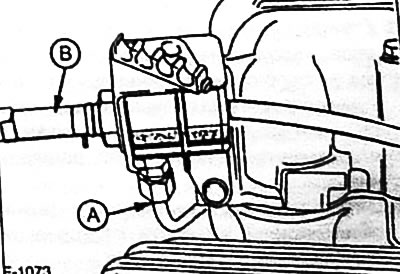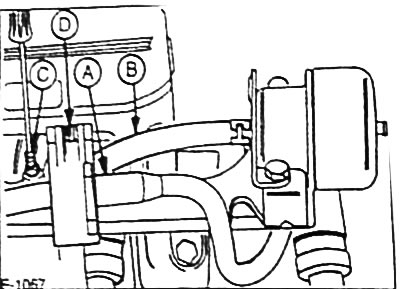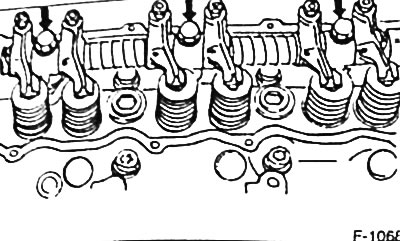Attention. 24-valve engine with a displacement of 2.9 liters (V6/24V, DOHC, Cosworth engine) is not considered here.
Note: the signs by which a defect in the cylinder head gasket is determined are given us. 15.
Withdrawal
Disconnect ground wire (-) battery.
Caution: Disconnecting the battery will erase the contents of the electronic memories, such as engine trouble codes or radio codes. Before switching off, also read the instructions in chapter "Removing and installing the battery".
Disconnect the crankcase breather hose from the oil filler neck.
Drain the coolant see p. 38.

Disconnect the plug-in connectors or unscrew the fastening of all electric cables going to the engine. To facilitate subsequent assembly, pre-mark the wires with adhesive tape.
- Connector for remote thermometer sensor -A-.
- Plug connector for coolant temperature sender -B-.
- Plug connector for idle speed control valve -C-.
- Plug connector for throttle position sender -D-.
- Combination connector for injector wiring harness -E-.
- Multi-pin plug connector of the ignition distributor.
Remove the air filter together with the suction hose, see p. 59.
Take off the throttle.
Release the clamps and disconnect the heating system hose, coolant hoses going to the expansion tank, and the upper radiator hose.

2.8 l engine: unscrew fuel supply line -A- to pressure regulator. Loosen clamp and disconnect fuel return hose -B- from pressure regulator.
Caution: To avoid splashing fuel, line the fuel lines with clean jolts and loosen fasteners carefully to relieve pressure in the fuel system.
Engine with a displacement of 2.4 and 2.9 liters

Use a screwdriver to release the fuel pressure through the bleeder valve -C-. At the same time, cover the valve with clean shaking.
Attention. When the engine is warm, it is necessary to remove air from the system several times.
Disconnect fuel feed line -A- using FORD special tool 23-023-A.
Release clamp and disconnect fuel return hose -B-.
Disconnect all vacuum hoses leading to the cylinder head. To facilitate subsequent assembly, mark the hoses with adhesive tape. Disconnect vacuum hoses from:
- fuel pressure regulator
- MAP sensor air chamber
- EGR valve
- throttle body
- T-fitting ventilation valve cover
Remove the 6 mounting bolts and remove the air chamber from the intake manifold.
Remove the spark plug caps, then remove the distributor cap.
Remove the ignition distributor see p. 48.
Remove the V-belt see p. 29.
Remove the generator see p. 164.
Loosen the bracket for the power steering pump and hang the pump with the attached hoses on a wire so that it does not interfere with further dismantling and that the hoses are not stretched.
Loosen the clamp and disconnect the coolant hose from the intake manifold end cap.
Remove cylinder head cover.

Unscrew the fastening of the rocker axles and remove them together with the oil catcher. Mark the axes of the rocker arms with a felt-tip pen like this. so that during assembly they can be installed in their original places.
Attention: For a 2.9 liter engine equipped with a catalytic converter, do not change the position of the adjusting screws in the rocker arms.
Take out the push rods and put them in like this. so that they can be installed in their original places.
Remove valve injectors complete with wiring harness and fuel manifold, see p. 70.
Remove the 8 mounting bolts and remove the intake manifold. If the intake manifold cannot be removed, lift it with a lever.
Attention: Do not damage the sealing surfaces.
Unbolt the front exhaust pipe to the exhaust manifold, see p. 80.
Remove spark plugs.

Loosen the cylinder head bolts in sequence from 8 to 1, first loosen them by about 1/2 turn, then unscrew the bolts completely. The figure shows the right cylinder head. With regard to the left cylinder head, operations are performed in the same sequence.
Caution: Loosening the bolts in the wrong sequence can warp or crack the cylinder head.
Check that all pi hoses and wires from the cylinder heads to the engine and body are disconnected.
With the help of an assistant, remove the cylinder heads from the engine.
Attention: Removed cylinder heads must not be placed directly on the sealing surface, as fully open valves may be damaged. Place the cylinder heads on 2 wooden blocks.
Installation
Clean the sealing surfaces of the crankcase, intake manifold and cylinder heads from seal residues with a suitable scraper. Never scratch the sealing surfaces. When doing this, make sure that dirt does not get into the bores of the cylinder block. Cover holes with rags.
Check the cylinder heads for cracks and the cylinder sliding surfaces for notches.
Check the cylinder head bolt holes for oil. If compressed air is not available to blow through the holes, use a small screwdriver to insert a clean rag into the holes to soak up the oil.
Attention: The oil from the holes must be removed in any case.
Cylinder head gaskets must be replaced.
Attention: Install cylinder head gaskets in accordance with the marking OBEN FORN (TOP FRONT). Sealing gaskets for the right and left cylinder heads are not the same.
Lay new cylinder head seals without sealant on the guide bushes so that they do not block any openings.
Install cylinder heads.
New fastening bolts in the area of heads and threads are easy to lubricate and tighten by hand until they stop.
Caution: The cylinder head bolts must be replaced.

Tighten the cylinder head bolts with a torque wrench in 3 steps. In each step, the bolts are tightened in sequence from 1 to 8.
Attention: The cylinder head bolts are manufactured in two versions and are tightened with different torques.
Tightening torques for hexagon bolts:
- Reception 1: 55 Nm
- Reception 2: 70 Nm.
- Reception 3: after a 15-minute pause 115 Nm.
Note: After installation is complete and the engine has warmed up, the hexagon bolts must be tightened to 115 Nm.
Tightening torques for bolts with internal slots in the head:
- Reception 1: 40 Nm.
- Reception 2: 75 Nm.
- Technique 3: after a 5-minute pause, use the locked key to tighten by 90°.
Note: Do not retighten the socket head bolts after the installation has been completed and the engine has warmed up.
Caution: Tighten the cylinder head bolts very carefully. The torque wrench must be checked for accuracy before tightening. To facilitate tightening operations at a certain angle, a special protractor is required, for example, HAZET 6690. If a special protractor is not available, put a torque wrench on the bolt so that its handle is located along the cylinder head, set aside the desired angle using a conventional protractor and mark the appropriate mark on the head with chalk cylinders.
Install the front exhaust pipe see p. 80.

Joints between the crankcase and cylinder heads at the intake manifold flanges (shaded in the figure) thoroughly clean and apply sealant FORD 85 ТМ 19554 AA.
Install a new intake manifold gasket and intake manifold.

Tighten the intake manifold mounting bolts with a torque wrench in 4 steps. In each step, the bolts are tightened in sequence from 8 to 1.
- Reception 1: 8 Nm
- Reception 2: 15 Nm
- Reception 3: 20 Nm
- Reception 4: 25 Nm
Connect the coolant hose to the intake manifold end cap and secure with a clamp.
The push rods are easy to lubricate and insert into their original places in the crankcase holes. Make sure that the rods are in the thrust bearings.
Attach the rocker axles together with the oil deflector and fastening bolts in accordance with the marks made before removal. At the same time, press the adjusting screws of the rocker arms against the spherical heads of the push rods. Tighten the rocker arm axle bolts to 70 Nm.
Attention: For a 2.9 liter engine equipped with a catalytic converter, do not change the position of the adjusting screws in the rocker arms.
Install the ignition distributor see p. 48.
Engines with a displacement of 2.4 and 2.8 liters: check the clearances in the valve drive, see p. 26.
Clean the joints between the cylinder heads and the intake manifold at the sealing surfaces for the cylinder head covers and apply FORD 85 TM 19554 AA sealant to them.
Glue the new gaskets to the cylinder head covers with the adhesive side.
Fit cylinder head covers with gaskets and tighten to 10 Nm.
Screw in spark plugs and tighten to 40 Nm.
Install the ignition distributor cap and put on the spark plug tips in accordance with the firing order of the cylinders (1-4-2-5-3-6).
Install the generator see p. 164.
Attach the power steering pump and tighten the bracket fastening to 60 Nm.
Install throttle.
Install the V-belt see p. 29.
Install valve injectors complete with fuel manifold and wiring harness. Tighten the fuel manifold mounting bolts to 10 Nm.
Attention: Fit valve injectors with new O-rings.
Attach the air chamber with a new gasket to the intake manifold and tighten the mounting bolts to 10 Nm. Connect the vacuum hose to the left cylinder head cover.
Connect in accordance with the designations applied before removal and secure all electrical wires and vacuum hoses.
2.8 l engine: Screw the fuel supply line to the pressure regulator. Connect the fuel return hose to the pressure regulator and secure it with a clamp.
2.4 and 2.9 liter engines: connect the fuel supply line to the plastic ring located on the supply pipe, centering the coil spring. If the connection is fixed, the ring pops up. Connect the fuel return hose and secure it with a clamp.
Connect the crankcase ventilation hose to the oil filler cap.
Connect and secure with clamps the coolant hoses going to the heating system, expansion tank and upper radiator pipe.
Install the air filter together with the suction hose, see p. 59.
Check engine oil level, top up if necessary. If the cylinder head gasket is damaged, replace the engine oil and oil filter as There may be coolant in the engine oil.
Check the concentration of antifreeze in the coolant and fill in the coolant, see p. 38.
Connect ground wire (-) battery.
If available, set the clock and enter the radio's anti-theft code.
Engines with a working volume of 2.4 and 2.9 liters: turn on the ignition and through the valve -C- (see figure F-1067) remove air from the fuel system. To do this, push the valve with a screwdriver until fuel flows through it.
Check and, if necessary, adjust the ignition timing, see p. 50.
Check and, if necessary, adjust the engine idle speed see p. 64.
Warm up the engine to operating temperature. check engine oil and coolant levels and check all hose connections for leaks.
Engine with hex bolted cylinder heads after reaching operating temperature (at coolant temperature approx. +90°C) stop the engine and unscrew the fastening of the cylinder head covers. Tighten the cylinder head bolts in the sequence shown in Figure F-1069 to 115 Nm. Tighten the cylinder head covers.

For an engine warmed up to operating temperature (at a coolant temperature of approximately +90°C) Tighten intake manifold mounting bolts to 25 Nm. At the service station, a special FORD 21-144 tool is used for this. If this tool is missing, it is necessary to unscrew the fastening of the air chamber and, after tightening the bolts, reinstall it with a new seal.
Visitor comments